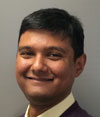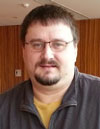Extending Moore’s Law through Innovative Active Cooling
Click here to download the presentation.
Overview: Phononic intends to lead a discussion with thermal engineers, hardware designers, and architects on the merits of passive fan assists, water cooling, and variable assist active cooling as it pertains to high density electronics. Specifically, the discussion will focus on the pros and cons of different approaches to electronics cooling and the impact on system performance from component temperature control, form factors, power consumption and cost trade-offs. Attendees will gain an understanding of the most recent advances in electronics cooling, including the ability to use active heat pumps based on thermoelectric devices, to provide superior cooling performance while minimizing the aggregate capex and opex costs.
Moderator:
 Chris Caylor
Chris Caylor
Chris is the Technical Director of the Electronics Cooling Business Unit at Phononic. He earned his PhD in Chemistry from the University of California at Berkeley. He is an engineering, research and product leader with over 10+ years in managing engineering programs and teams. Chris also has 6+ years experience in winning and managing government programs from diverse sources such as DoD, DoE and DARPA, as well as commercial program management with defense contractors, automotive OEM’s. Chris also has 5+ years of product development and business development experience in the alternative energy, cleantech and cold products space. Chris is a recognized leader in advanced thermoelectric materials systems and device integration as well as compound semiconductors (including group IV, II-VI, III-V and V-VI) and their deposition techniques.
Panelists:
 Abhishek Yadav, Sr. Device and Applications Engineer – Abhishek Yadav graduated with a PhD from University of Michigan in Mechanical Engineering. His main interests lie in the development of novel cooling technologies based on solid state heat pumping. He has 4+ years’ experience in designing thermoelectric modules, assemblies and systems for applications ranging from electronic cooling, telecom, and, refrigeration. He is also an experienced applications engineer supporting the development of efficient cooling and heating systems.
Abhishek Yadav, Sr. Device and Applications Engineer – Abhishek Yadav graduated with a PhD from University of Michigan in Mechanical Engineering. His main interests lie in the development of novel cooling technologies based on solid state heat pumping. He has 4+ years’ experience in designing thermoelectric modules, assemblies and systems for applications ranging from electronic cooling, telecom, and, refrigeration. He is also an experienced applications engineer supporting the development of efficient cooling and heating systems.
 Jesse Edwards, Director of Systems Engineering – Mr. Edwards has over 20 Years of experience in entrepreneurism and new product development, with more than 10 years dedicated to the development and manufacturing of alternative and traditional refrigeration and cooling technologies, including solid-state, single stage/cascade vapor compression, Stirling, and cryogenic liquid methods. Jesse specializes in the management and transport of thermal energy and has developed a variety of high performance, passive heat-transport systems, designed to eliminate system level parasitics and augment the efficacy of a wide variety of heat pumping technologies. Prior to joining Phononic he spent more than 3 years developing and manufacturing a variety of laboratory/medical products and appliances, including cascaded/auto-cascade vapor compression freezer, refrigeration and cryogenic sample storage products with Thermo Fisher Scientific. From 2004 to 2009 he worked to develop and commercialized a variety of Stirling Cycle based cooling products and appliances for the consumer, commercial, medical and industrial markets with Global Cooling Inc. From 1992 to 2004 he worked as an entrepreneur within the IT and telecommunications industry pioneering the consumer roll-out of K and Ku band geosynchronous satellite entertainment and wireless data transmission and reception hardware. Jesse holds a BSME from Ohio University with a post-graduate specialization in thermodynamics, fluid-dynamics, Fuel-cells and Stirling Cycle machinery.
Jesse Edwards, Director of Systems Engineering – Mr. Edwards has over 20 Years of experience in entrepreneurism and new product development, with more than 10 years dedicated to the development and manufacturing of alternative and traditional refrigeration and cooling technologies, including solid-state, single stage/cascade vapor compression, Stirling, and cryogenic liquid methods. Jesse specializes in the management and transport of thermal energy and has developed a variety of high performance, passive heat-transport systems, designed to eliminate system level parasitics and augment the efficacy of a wide variety of heat pumping technologies. Prior to joining Phononic he spent more than 3 years developing and manufacturing a variety of laboratory/medical products and appliances, including cascaded/auto-cascade vapor compression freezer, refrigeration and cryogenic sample storage products with Thermo Fisher Scientific. From 2004 to 2009 he worked to develop and commercialized a variety of Stirling Cycle based cooling products and appliances for the consumer, commercial, medical and industrial markets with Global Cooling Inc. From 1992 to 2004 he worked as an entrepreneur within the IT and telecommunications industry pioneering the consumer roll-out of K and Ku band geosynchronous satellite entertainment and wireless data transmission and reception hardware. Jesse holds a BSME from Ohio University with a post-graduate specialization in thermodynamics, fluid-dynamics, Fuel-cells and Stirling Cycle machinery.
The following are questions presented to the speaker by the attendees during the webinar, along with answers to each.
Do you see thermoelectrics gaining traction in new product areas and if so, where and why?
Answer: Yes! The use of high-performance thermoelectric devices integrated with low loss heat exchangers and smart electronics can offer high efficiency cooling and thermal management. This is helping thermoelectrics gain new ground in refrigeration/freezing as well as electronics cooling.
We have found CoP can be a misleading metric of performance, as it is 1 dimensional. Do you ever use another metric?
Answer: COP only tells part of the story, especially when it is applied to the thermoelectric heat pump only compared to competitive technologies like compressors. Wall plug energy usage is the best metric and takes into account many more sytem aspects: heat exchanger, electronics, system insulation and design.
Can you elaborate more about preventing condensation?
Answer: Preventing condensation usaully falls on the electronic control system. Monitoring temperatures and humidity at differenet parts of the system and feeding that back to the controller allows firmware to maximize cooling while protecting the system from condensation.
In our application (cooling vest using TEC), generally we get more than 1 COP because in general, the body temperature is more than ambient, so for this gradient, we get more than 1 COP, but the problem is curvature of TEC surface to take body profile. So my question is, when can flexible TEC available in market, using flexible ceramics polymer with printed high ZT p – n junctions inside?
Answer: Flexible thermoelectric devices have been explored by different companies, but none are on the market to our knowledge. Here is a link to a good article about these types of devices: http://www.electronics-cooling.com/2014/04/thermoelectic-body-heat/
I am trying to cool a box with TEC system. When the box is reaching the required temperature, the power to TEC is being cut off (Just like AC or refrigerator thermostat), and then TEC restarts again when box temperature increases, and so on. Is there any solid material which can allow heat transfer in only one direction and not in reverse direction (i.e. unidirectional), so that overall cooling TEC system is efficient…….basically I’m looking for a thermal diode kind of device. (The space is very small to accomodate heat pipes as thermal diodes.)
Answer: Yes, thermosyphons can act with some thermal diode capabilities. Our experience is that they can easily achieve a 10:1 diodicity in allowing heat to flow one way but not the other. Be aware that the heat flow is dependent on gravity in these cases.
How do i prevent TEM from shear loading? Pellets are weak in this direction.
Answer: Good mounting design is key. Use even loading, with no pressure points on corners or edges. Symmetric screws or perimeter pressure is important to insure even pressure. Also, thermoelectric devices are usually strong in compression and can withstand 100psi or more in most cases. This also helps to limit shear loads.
What is the frequency limit for TEC power input system design not to get thermal stresses?
Answer: TECs are direct current (DC) devices. Using AC power does not allow them to operate in a cooling mode. If you mean the frequency limit for PWM, then there is no effective limit. The thermal stress is built up when the TEC changes temperatures, so that depends on the TEC loading and power combined.
Any recommended solutions for efficient dehumidification of a container cooled by TEC below dew point?
Answer: Normal dehumidification can be employed, but a 2nd cooling loop could be added to dehumidify the air and allow for easy exit of the water.
I don’t see anywhere in the power balance of system that the fan motor heat would be taken into consideration. Is that negligible?
Answer: Typically, the fan motor produces only a few watts of power. In larger systems, this is negligible, but in small systems the location of the fan and the heat it produces could be a factor.
What about thermoelectrics using convention instead of conduction, using water loops and pumps and radiators?
Answer: Thermoelectric devices can be used in conjunction with almost any other thermal management strategy – most important is to design with the full system in mind to minimize the thermal drops outside the thermoelectric so it can run most efficiently.